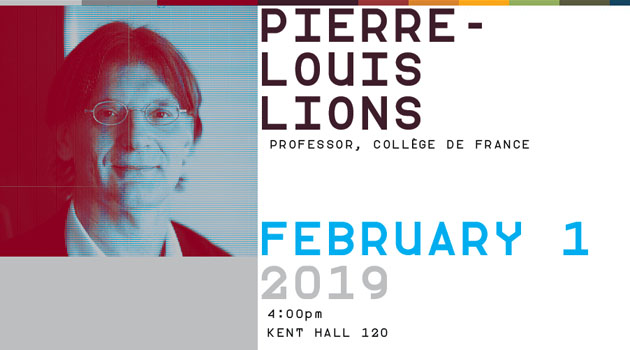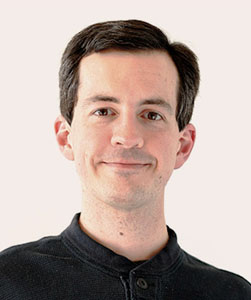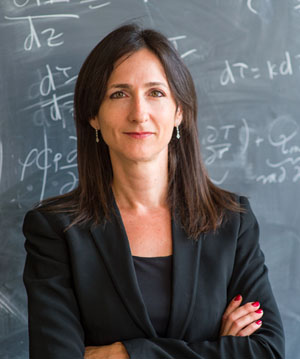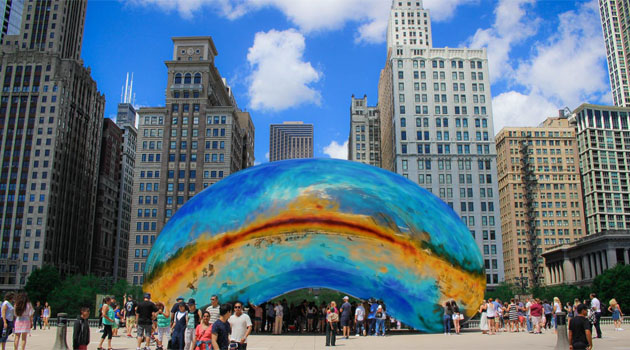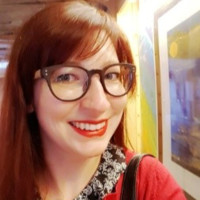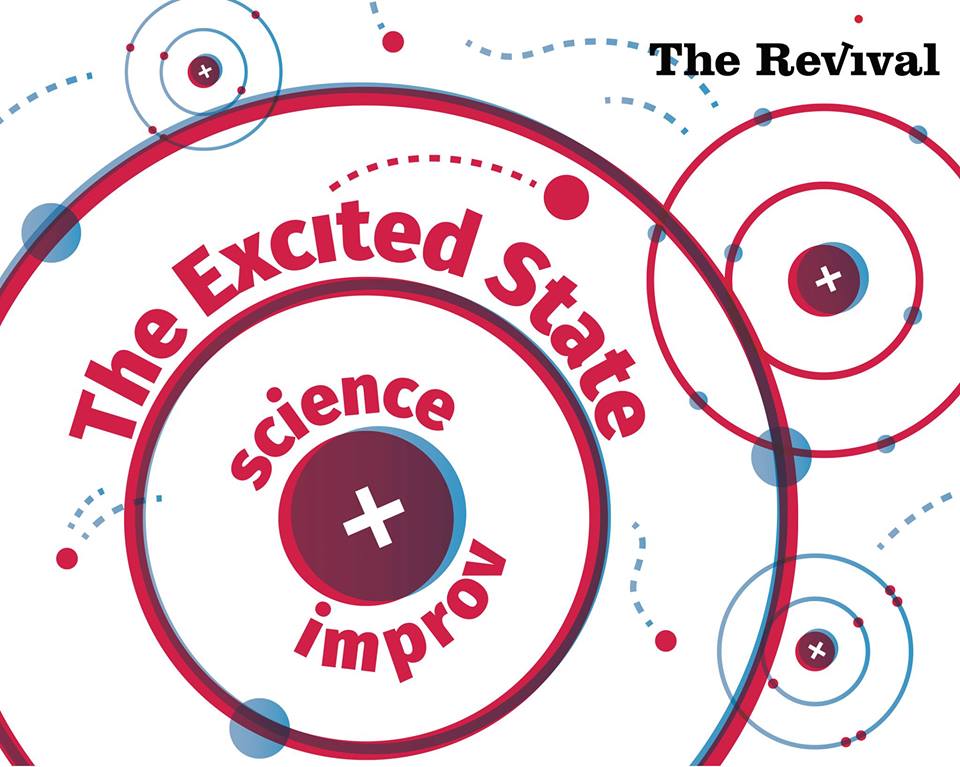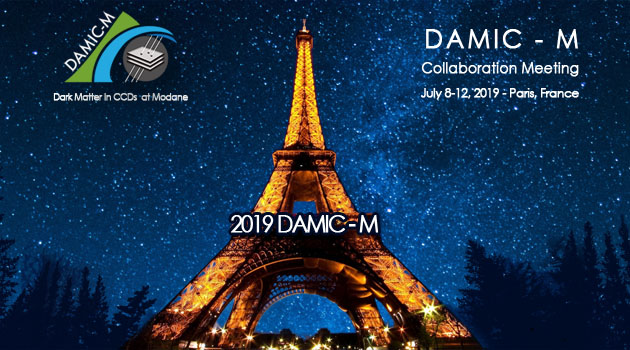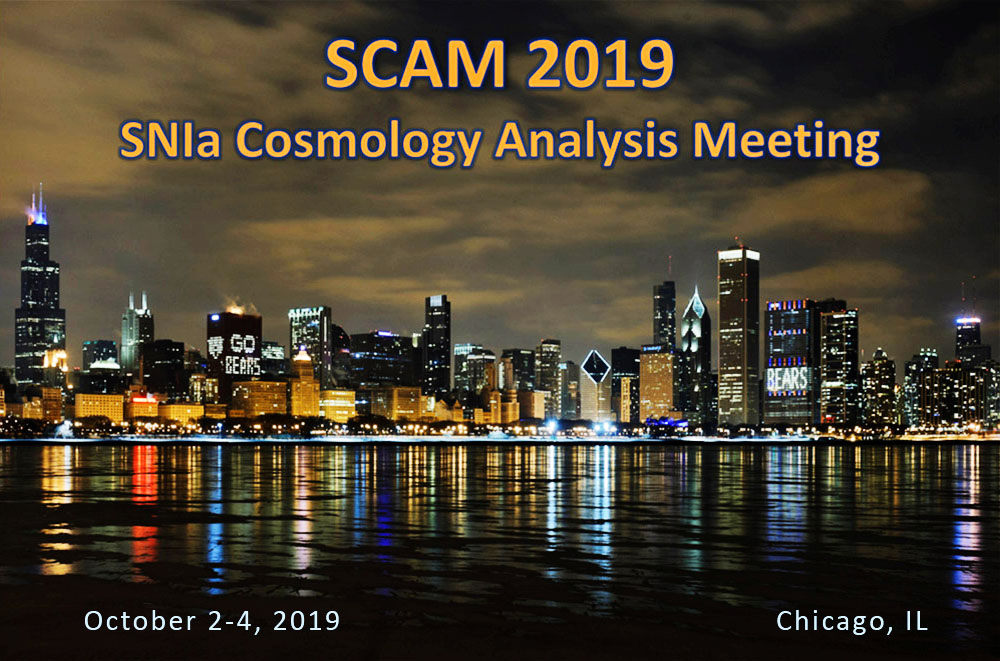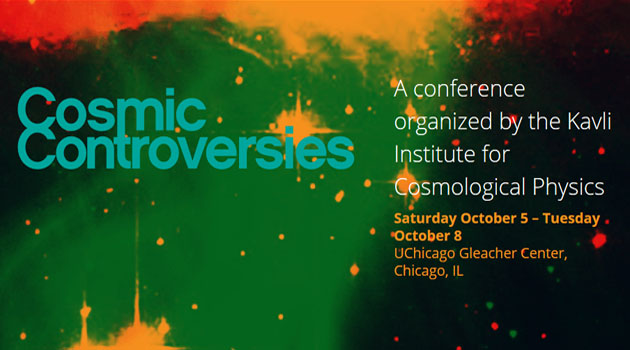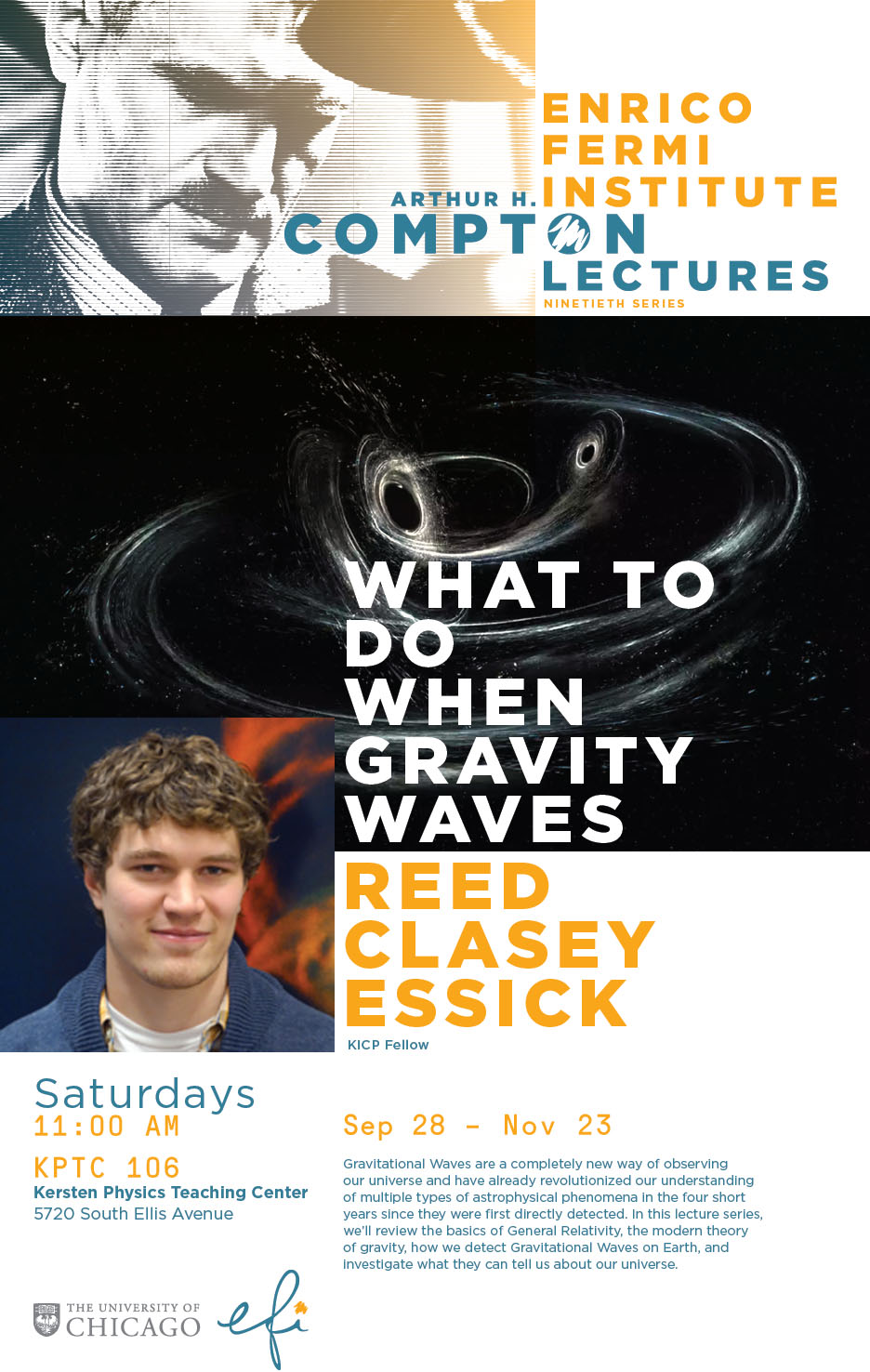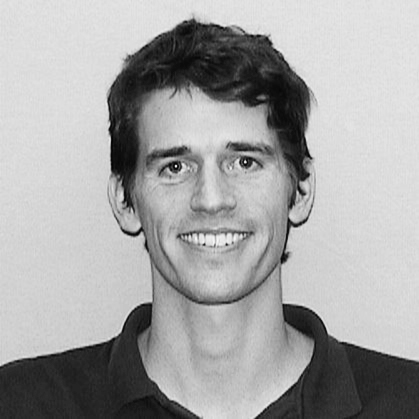|
|
| January 7, 2019 | EFI colloquium: Damiano Caprioli, "On the origin of the cosmic radiation - 70 years later (a tribute for Fermi's pioneering paper of 1949)" | | February 1, 2019 | PSD colloquium: Pierre-Louis Lions, College de France, "Mean Field Games: What? Why? How?" | | February 21, 2019 | Physics colloquium: Marc Kamionkowski, Johns Hopkins University, "Heretical hypotheses in the hunt for dark matter" | | February 25 - 26, 2019 | Midwest Workshop on Supernovae and Transients | | March 7, 2019 | Broader Horizons: Stephen Hoover, Civis Analytics | | March 8, 2019 | Winter 2019 Postdocs Symposium | | April 9, 2019 | Sara Seager, "Exoplanets and the Search for Habitable Worlds" | | April 15 - 16, 2019 | Workshop: "Astrophysics with the CMB-S4 Survey" | | April 25, 2019 | Broader Horizons: Nicole Larsen, AAAS Science and Technology Policy Fellow | | May 2, 2019 | GeoSci Seminar: Christina Richey, NASA JPL, "The Europa Clipper Mission" | | May 6, 2019 | EFI Colloquium: Zohar Komargodski, "The Power of Conformal Symmetry" | | May 9, 2019 | The Excited State - Improv Comedy Show feat. Prof. Brian Nord PhD | | May 23, 2019 | IDEA Day - Inclusion, Diversity and Equity in Astronomy | | June 3, 2019 | Astrophysics Majors: first graduating class | | June 21, 2019 | Spring 2019 Postdocs Symposium | | July 8 - 12, 2019 | 2019 DAMIC-M: DAMIC-M collaboration meeting | | August 5 - 7, 2019 | LSST Dark Matter Workshop | | September 23 - 27, 2019 | Graduate student orientation | | October 2 - 4, 2019 | SCAM-2019: SNIa-Cosmology Analysis Meeting | | October 5 - 8, 2019 | Conference: Cosmic Controversies | | October 19, 2019 | 90th Compton Lecture: Reed Clasey Essick, "What to Do When Gravity Waves" | | October 21, 2019 | 2nd Annual John A Simpson Lecture - Alan Watson | | October 24, 2019 | Broader Horizons: Ryan Keisler, Descartes Labs | EFI colloquium: Damiano Caprioli, "On the origin of the cosmic radiation - 70 years later (a tribute for Fermi's pioneering paper of 1949)" A theory of the origin of cosmic radiation is proposed according to which cosmic rays are originated and accelerated primarily at the blast waves of supernova remnants and in relativistic jets of active galactic nuclei. One of the features of the theory is that it yields naturally a power law for the spectral distribution of the cosmic rays and explains in a straightforward way the heavy nuclei observed in the primary radiation. PSD colloquium: Pierre-Louis Lions, College de France, "Mean Field Games: What? Why? How?" Click on the image to enlarge Mathematics presents Pierre-Louis Lions, Professor, College de France Pierre-Louis Lions is one of the most well known mathematicians of our time. He graduated from the Ecole Normale Superieure in 1977, and received his doctorate from the University of Pierre and Marie Curie in 1979. His main work is on the theory of nonlinear partial differential equations. He received the Fields Medal (comparable to a Nobel Prize) for his work in 1994. Lions was the first to give a complete solution to the Boltzmann equation with proof. He has received numerous other awards. Currently, he holds the position of Professor of Partial differential equations and their applications at the prestigious College de France in Paris as well as a position at Ecole Polytechnique. In the paper "Viscosity solutions of Hamilton-Jacobi equations" (1983), written with Michael Crandall, he introduced the notion of viscosity solutions. This has had a great effect on the theory of partial differential equations. More recent work includes the theory of mean-field games, which promises to be highly influential in economics. Pierre-Louis Lions has also been interested for a long time in mathematical finance writing seminal papers on a variety of subjects, such as the use of Malliavin calculus, Monte Carlo methods, applications of stochastic control, and convexity properties. Physics colloquium: Marc Kamionkowski, Johns Hopkins University, "Heretical hypotheses in the hunt for dark matter" We have known for a reasonable fraction of a century that most of the matter in the Universe is dark, and for several decades that it cannot be baryonic. The nature of this dark matter has, however, been elusive. The prevailing weakly- interacting massive particle (WIMP) hypothesis that have long been theorists preferred guess faces considerable pressure from an array of null searches, and this has led theorists to consider previously unpalatable alternatives. I will discuss the rise, and possible fall, of an idea that connected LIGOs discovery of black-hole binaries to dark matter. I will also discuss recent ideas (motivated in part by an intriguing recent experimental result) that involve particles with enhanced couplings to ordinary matter. Midwest Workshop on Supernovae and Transients Click on the image to enlarge WebsiteThe purpose of the workshop is to bring together the Midwest community interested in supernovae of all types, and Galactic and extragalactic transients in general, including kilonovae, fast radio bursts, TDEs, gamma-ray bursts, novae, X-ray binaries, and anything that varies on a short timescale. We will deal with all aspects of these objects, including the explosion mechanism, progenitors, evolution, nucleosynthesis, and radiation over all wavelengths from radio to gamma-rays. Ample time would be given to students and postdocs, and significant time reserved for discussions. The workshop is organized by the Department of Astronomy and Astrophysics at the University of Chicago. Broader Horizons: Stephen Hoover, Civis Analytics Organizer: Andrew Neil Interested in a career in data science? What does a data scientist do, exactly, and how does a physicist or astronomer become a data scientist? Stephen is a data scientist at the Chicago-based company Civis Analytics, where he helps to build predictive modeling tools for Civis's software offerings and consulting work. He received his PhD in physics from UCLA, and went on to work with the South Pole Telescope group as a postdoc. He joined Civis Analytics in 2014, and in this talk, will discuss his transition from academia and the current nature of a data scientist's job. Winter 2019 Postdocs Symposium - 12:00PM - 12:45PM Lunch
- 12:45 - 1:00 Dimitrios Tanoglidis
- "Shadows in the dark: searching for Ultra Diffuse Galaxies in the DES data"
Recent astronomical surveys have provided unprecedented sensitivity to extremely low surface brightness "ultra-diffuse" galaxies. These extreme galaxies have sizes comparable to that of the Milky Way (radii 1.5 -10 kpc), but stellar content ~1% of it (central surface brightness μ,0 ∼ 24 − 26 mag arcsec−2). This makes UDGs some of the most dark-matter-dominated systems known. It is currently unclear whether UDGs and more compact field dwarf galaxies have a common or whether their formation is fundamentally different. In this talk I will give a review of the current theoretical and observational literature and I will show how the Dark Energy Survey (DES) will be important for addressing the global distribution of environments for UDGs, as well as some preliminary results of this search.
- 1:00 - 1:30 Marco Raveri
- 1:30 - 2:00 Nesar Ramachandra
- "Variational autoencoders for the emulation of cosmological functions"
Future cosmological surveys demand high precision requirements on the estimation of cosmological parameters. Substantial improvements on calibration have been achieved using fast emulators of cosmological functions. We present a novel approach to Gaussian process emulation by using an unsupervised learning algorithm of Variational Autoencoders. We compare it to the more classical principal component decomposition. A specific application of CMB power spectra is shown to achieve sub-percent level errors over wide ranges of cosmological parameters.
- 2:00 - 2:15 William Wolf
- "Instabilities in Cosmological Models Beyond LCDM"
Explaining the observed accelerated expansion of our universe is an important challenge within the current theoretical framework of physics. This question has inspired the development of theories beyond the standard Lambda-CDM paradigm that invoke dynamical models of dark energy or more direct modifications of gravity. In this talk, I will discuss the presence of ghost, gradient, and tachyonic instabilities within these models and how they impact their viability. I will also look at how we can use canonical transformations to highlight the relationship between these three pathological instabilities.
- 2:15 - 2:30 Hanjue Zhu
- "Cosmic Reionization On Computers: Reionization Histories of Present-day Galaxies"
The gas content in the present day intergalactic medium (IGM) between galaxies is highly ionized. The history and sources of this ionization is one of the outstanding question in studies of galaxy formation. One of the interesting topics in reionization studies is ionization histories of individual galaxies, including the Milky Way. We examine the reionization history of present-day galaxies in numerical simulations from the Cosmic Reionization On Computers project. We use three $40,h^{-1},{m Mpc}$ reionization simulations to study the neutral fractions at positions of particles that belong $z=0$ halos during rapid global reionization, $6lsim zlsim 9$. We find a systematic trend of reionization redshift with mass - present day halos with higher masses have earlier reionization times.
- 2:30 - 3:00 Reed Essick
- "Non-parametric Inference with Gravitational-Waves and Other Things I think About"
I'll discuss a few uses for non-parametric inference within the context of well resolved Gravitational-Waves events that I'm currently working on, focusing on inferring the Equation of State of dense nuclear matter but also describing preliminary work on detecting anisotropic merger distributions. With the third observing run (O3) starting in April, I'll also discuss how this work connects to my general excitement and fear of the coming data.
- 3:00 - 3:30 Coffee break
- 3:30 - 4:00 Brian Nord
- "AI in astrophysics and the ethics of AI applications"
- 4:00 - 4:15 Joao Caldeira
- "Quantum Machine Learning for Astrophysics"
While the era of quantum supremacy is not upon us yet, recent developments make it clear that, like winter, it is coming. In this talk I will present preliminary results, roadblocks, and successes in training machine learning models for classification of astrophysical objects with quantum annealers. We hope that the lessons learned will prove useful as computers with more qubits become available.
- 4:15 - 4:30 Georgios Zacharegkas
- "Galaxy-galaxy weak lensing with HOD"
One of the most powerful probes of the relation between dark matter halos and the galaxies they host is galaxy-galaxy weak lensing. Modeling this phenomenon requires very careful treatment of the various contributions to the final signal from central and satellite galaxies. At small scales the main contribution comes from matter distribution inside the lens dark matter halo. Correlations with neighboring halos start to dominate at large scales. We use the framework of the Halo Occupation Distribution (HOD) to fit the model to data and constrain the mass of the lens halo. Our data for the lenses consists of redMaGiC galaxies over a wide range of redshift, 0.2 < z < 0.8. We demonstrate that with our numerical tools we are able to constrain the model parameters and deduce the mass of the lens halo. The same tools can be applied to a wide variety of lenses, thus enabling us to explore the relation between dark matter and galaxies of different types.
- 4:30 - 5:00 Meng-Xiang Lin
- "Separate universe and consistency relation beyond slow-roll inflation"
We clarify the difference between various gauge-invariant quantities typically used in inflation. We show that whereas inflationary consistency relations are calculated to the unitary curvature $zeta_u$, the separate universe condition is determined by the synchronous curvature $zeta_s$. Due to this difference, the separate universe is not enough to have consistency relations, which we illustrate with an explicit example. In addition, we show that the comoving curvature, typically used for evolving primordial perturbations after inflation, does not always coincide with the unitary curvature outside the horizon. This difference must be taken into account when translating inflationary quantities to initial conditions for the universe during radiation and matter domination.
- 5:00 - 5:30 Yu-Dai Tsai
- "Multi-messenger Searches for Dark Matter: Quiet Kilonova, Light Black Hole, and Neutron Star Merger Distribution"
Dark matter-induced neutron star implosions could give astrophysical signatures including light (~ 1-2 solar mass) black hole mergers, quiet kilonova, and potentially, fast radio bursts. The implosions can significantly change the spatial distribution of the neutron star merger events in galaxies, allowing us to explore some dark matter parameter space 5 - 10 orders of magnitude in cross-section beyond the reach direct detection experiments. The implosions also explain peculiar pulsar distribution near the galactic center. We explore all these signatures and detail an updated search for kilonovae in the Dark Energy Survey and a Dark Energy Camera telescope proposal, partly motivated by finding a quiet kilonova. This work is based on arXiv:1706.00001 (PRD '18).
- 5:30 - 6:30 Reception
Sara Seager, "Exoplanets and the Search for Habitable Worlds" Sara Seager, 2019 Brinson Lecturer Sara Seager is an astrophysicist and planetary scientist at MIT. Her science research focuses on theory, computation, and data analysis of exoplanets. Her research has introduced many new ideas to the field of exoplanet characterization, including work that led to the first detection of an exoplanet atmosphere. She received her Ph.D from Harvard University in 1999. Before joining MIT in 2007, Professor Seager spent four years on the senior research staff at the Carnegie Institution of Washington preceded by three years at the Institute for Advanced Study in Princeton, NJ. Professor Seager is on the advisory board for Planetary Resources. Professor Seager was elected to the National Academy of Sciences in 2015, is a 2013 MacArthur Fellow, the 2012 recipient of the Raymond and Beverly Sackler Prize in the Physical Sciences, and the 2007 recipient of the American Astronomical Society's Helen B. Warner Prize. She has been recognized in the media, most recently in Time Magazine's 25 Most Influential in Space in 2012. 2019 Brinson Lecture: "Exoplanets and the Search for Habitable Worlds" For thousands of years people have wondered, "Are there planets like Earth?" "Are such planets common?" "Do any have signs of life?" Today astronomers are poised to answer these ancient questions, having recently found thousands of planets that orbit nearby Sun-like stars, called "exoplanets". Professor Sara Seager will share the latest advances in this revolutionary field. This event is co-sponsored by the University of Chicago and the School of the Art Institute of Chicago. Workshop: "Astrophysics with the CMB-S4 Survey" WebsiteThe purpose of the workshop is to bring together leading astronomers and astrophysicists to integrate the planned CMB-S4 Legacy Survey, a multi-band millimeter wave survey covering roughly half the sky at unprecedented sensitivity and observing cadence, with other directions in astrophysics. This includes the time variable sky as seen in solar system science, stellar variability, binary evolution, supernovae, tidal disruption events, and gamma-ray bursts, as well as high-redshift star formation and studies of feedback from black holes and star formation on the intergalactic medium, including galaxy cluster thermodynamics and reionization. Broader Horizons: Nicole Larsen, AAAS Science and Technology Policy Fellow Organizer: Andrew Neil Nicole Larsen is a 2018-2019 AAAS Science and Technology Policy Fellow at the US Department of Defense (and a previous KICP Fellow). In this talk, she will discuss the Venn Diagram of science and public policy - where they intersect, how policy benefits from science, and what a career in policy might have to offer a STEM PhD - and she will talk about her path from physics to policy and her day-to-day life in the federal government. GeoSci Seminar: Christina Richey, NASA JPL, "The Europa Clipper Mission" The Europa Clipper Mission, in formulation for launch in 2023, will investigate the potential habitability and recent activity of Jupiter's moon Europa through investigations that will study the space environment, surface, and interior. The mission will send a solar-powered, radiation-tolerant spacecraft into an initially highly-elliptical orbit about Jupiter and then will conduct more than 40 flybys of Europa, most reaching closest approaches of 25-100 km. The payload comprises a suite of science instruments that together will support three key objectives:
1. Ice Shell & Ocean:Characterize the ice shell and any subsurface water, including their heterogeneity, ocean properties, and the nature of surface-ice-ocean exchange
2. Composition: Understand the habitability of Europa's ocean through composition and chemistry
3. Geology: Understand the formation of surface features, including sites of recent or current activity, and characterize high science interest localities
This talk will focus on the science objectives and instruments being utilized to achieve those objectives, the unique team structure and dynamics, and the current work of the team as they prepare to enter the building phase of the mission. EFI Colloquium: Zohar Komargodski, "The Power of Conformal Symmetry" Many physical systems enjoy conformal symmetry (exact or approximate) in various circumstances. We review the consequences of conformal symmetry for the kinematics and the dynamics of the theory. We show how from purely algebraic considerations exact results about the critical exponents can be obtained. We also review recent progress on the properties of conformal plasmas. The Excited State - Improv Comedy Show feat. Prof. Brian Nord PhD WebsiteFriends in the Chicago Science Community: We're excited to announce the next performance of "The Excited State" improv comedy show. This month"s Special Guest is Prof. Brian Nord (Fermilab and University of Chicago Department of Astronomy & Astrophysics). Science has never been so fun... or scientists so funny! "The Excited State" is an improv comedy show. The performance takes audiences on a hilarious---and utterly improvised---journey of discovery through scientific history, breakthroughs, and common misconceptions. The troupe is comprised of Chicago's most outgoing scientists from UChicago, UIC, IIT, Fermi Lab, Argonne and elsewhere. Each performance features a "Special Guest" from the scientific community. IDEA Day - Inclusion, Diversity and Equity in Astronomy The Diversity, Equity and Inclusion Journal Club (DEIJC) presents "IDEA Day", an afternoon of talks and dialogues at Astro-KICP, on the afternoon of May 23rd, 2019 (12:30-5pm). This event - the first of its kind organized by early career scientists - is supported by the Chicago Center for Teaching's Inclusive Pedagogy Grant 2018-19. This event is open to all members of the community, and is designed to foster community learning on the issues that marginalized astronomers and physicists face in academia.
The afternoon's speakers include:
a) Ashley Walker, undergraduate student at Chicago State University, on "The Miseducation of Black Junior Astronomers", highlighting the astrophysical contribution of black undergraduate and graduate students.
b) Dr. Khanh Nghiem, Clinical Psychologist at Student Counseling Services at UChicago, on "Mental Health at UChicago and Diversity Considerations'."
c) Keynote Speaker - Dr. Lucianne Walkowicz, Astronomer, Adler Planetarium, on "Choose Your Own Adventure: Developing A Values-Oriented Framework for Your Career'." Astrophysics Majors: first graduating class You are invited to attend a reception to honor our first graduating class of Astrophysics Majors and to celebrate the end of the academic year. When: 4:30pm - 6:30pm Monday June 3. Where: Hubble Lounge (ERC 501). You are also invited to the undergraduate thesis presentations of Elise Darrah-Ford and Max Goldberg prior to the reception: - 3:30 - 4:00 pm in ERC 576
Elise Darragh-Ford
Background understanding and rejection for CCD dark matter searches using DAMIC at SNOLAB
Adviser: Paolo Privitera (with Daniel Baxter) - 4:00pm - 4:30pm in ERC 576
Max Goldberg
Dynamical Detection of Singly-Transiting Circumbinary Planets
Adviser: Dan Fabrycky
Spring 2019 Postdocs Symposium - 12:15PM - 1:00PM Lunch
- 1:00 - 1:30 Kirit Karkare
- "High-Redshift Line Intensity Mapping with the SuperSpec On-Chip Spectrometer"
Tomographic line intensity mapping is a promising technique for measuring large-scale structure at redshifts higher than those accessible by traditional galaxy surveys. By detecting an emission line integrated over many faint sources, large cosmological volumes in three dimensions can be surveyed very quickly, potentially enabling access to orders of magnitude more modes for precision cosmology at z > 2. Targeting far-IR emission lines redshifted to the mm is particularly promising: they trace star formation in faint, early galaxies, and are detectable from the ground. But current mm-wave spectroscopic instruments do not yet have the sensitivity to detect these signals. SuperSpec is an on-chip mm-wave spectrometer that integrates the spectrometer and detector in just a few square cm of silicon. In this talk, I will describe the SuperSpec concept and our planned first deployment to the Large Millimeter Telescope this summer, where we will demonstrate on-sky performance by taking spectra of individual high-z galaxies. I will also discuss the potential for future SuperSpec instruments with an order of magnitude more sensitivity, and the cosmology and astrophysics that they would enable.
- 1:30 - 1:50 Amy Tang
- "Nanofabrication 101"
Ever wonder how people make CCDs or bolometers? Computer chips inside your cellphone? How about Josephson junctions for making qubits? In this talk, I will give a brief overview on nanofabrication, the techniques used to make these extraordinary devices at an extraordinarily small scale. I will discuss the physics behind thin film deposition, lithography, and etching. Lastly I will present an example process flow for making kinetic inductance detectors for CMB.
- 1:50 - 2:10 Ryan McGeehan
- "Design and fabrication of an on-chip spectrometer"
SuperSpec is a high sensitivity on-chip spectrometer for mm and sub-mm wave observations of high redshift dusty galaxies. The device deploys a filterbank architecture in which kinetic inductance detectors (KIDs) are coupled to resonant filters along a single microwave feedline. In this talk, I will discuss recent efforts to design and fabricate a new aluminum version of SuperSpec.
- 2:10 - 2:35 Karaoke Talk Meng-Xiang Lin (Hanjue's talk)
- "The Galaxy-Halo Connection during the Epoch of Reionization with the CROC simulations"
We explore galaxy properties in the CROC simulation and show how star formation rates evolve and translate to the evolution of the stellar mass function as well as the UV luminosity function. We also use the relationship between the UV luminosity and halo mass in CROC to calculate the galaxy bias, or the excess clustering of galaxies compared with the underlying matter, and compare with observational results.
- 2:35PM - 3:00PM Coffee break
- 3:00 - 3:25 Karaoke Talk Hanjue Zhu (Meng-Xiang's talk)
- "Acoustic Dark Energy: Potential Conversion of the Hubble Tension"
We discuss the ability of a dark fluid becoming relevant around the time of matter radiation equality to significantly relieve the tension between local measurements of the Hubble constant and CMB inference, within the ΛCDM model. We show the gravitational impact of acoustic oscillations in the dark fluid balance the effects on the CMB and result in an improved fit to CMB measurements themselves while simultaneously raising the Hubble constant. The required balance favors a model where the fluid is a scalar field that converts its potential to kinetic energy around matter radiation equality which then quickly redshifts away. We derive the requirements on the potential for this conversion mechanism and find that a simple canonical scalar with two free parameters for its local slope and amplitude robustly improves the fit to the combined data by ∆χ2 ≈ 12.7 over ΛCDM. We uncover the CMB polarization signatures that can definitively test this scenario with future data.
- 3:25 - 3:55 Nadejda Marounina
- "Internal Structure and CO2 Reservoirs of Habitable Waterworlds"
Water worlds are water-rich (>1% water by mass) exoplanets, that could form from volatile-rich material beyond the snow line but never attain masses sufficient to accrete or retain large amounts of H2/He nebular gas. This pathway for producing low-mass water-rich planets has played out as a robust prediction of planet formation simulations, leading to planets that could have a comet-like composition, with up to 50% of their mass constituted of astrophysical ices. If located at an appropriate orbital separation from their host star, water worlds may host a global surface water ocean. On the other hand, remnant cores of evaporated mini-Neptunes could be one of the dominant formation mechanisms for volatile-rich habitable zone planets around M dwarf stars. Habitable (liquid ocean-bearing) water worlds are especially timely because their larger sizes relative to terrestrial planets make them more amenable to observations with current and upcoming telescopes such as Hubble Space Telescope (HST) and James Webb Space Telescope (JWST). The classic calculations of the habitable zone consider Earth-like planets, where the amount of CO2 in the atmosphere is stabilized by the carbonate-silicate cycle. Due to their important oceanic mass, the hydrostatic pressure at the oceanic floor of water worlds reach the stability field of high pressure polymorphs of water ice, hindering chemical interactions between the liquid water and the silicates. In the absence of a carbonate-silicate cycle, the solubility of CO2 in the ocean and the formation of CO2-rich clathrates determine the concentration of CO2 in the water world's atmosphere. We use GERG-2008 equation of state for CO2-H2O mixture and coupled models of planet interiors, clathrate formation, liquid-vapor equilibrium, and atmospheric radiative transfer to constrain the atmospheric and interior abundance of CO2, and corresponding habitable zone boundaries of water world exoplanets.
- 3:55 - 4:25 Cosmin Deaconu
- "Radio Propagation in Ice, or: How I Learned to Start Worrying and Love FDTD"
Some of the experiments I work on (e.g. ANITA, ARA) try to detect the radio emission from ultra-high energy neutrinos interacting in polar ice. To understand our detector sensitivity, we have to to read glaciology papers and model the propagation of radio waves in ice. The detection of spooky "horizontal propagation," inexplicable by our simple models, has become surprising source of drama and intrigue in the in-ice radiodetection community. Can Finite-Difference Time-Domain (FDTD) simulations save the day? Might FDTD studies provide a path to a mundane explanation of the even spookier ANITA mystery events? What the heck is FDTD anyway? I will answer these important questions, or at least show some pretty animations.
- 4:25PM - 5:30PM Reception
2019 DAMIC-M: DAMIC-M collaboration meeting WebsiteThe 2019 DAMIC-M Collaboration Meeting will be held on July 8-12 in Paris, France. LSST Dark Matter Workshop WebsiteDark matter constitutes roughly 85% of the matter density of the Universe, and represents a critical gap in our understanding of fundamental physics. Despite extensive experimental efforts, the only robust, positive empirical measurement of dark matter continues to come from cosmological and astrophysical observations. The Large Synoptic Survey Telescope (LSST) offers a versatile platform to investigate dark matter. This workshop will focus on new ideas for probing the fundamental nature of dark matter with LSST and other future observations. Potential discussion topics for this workshop Include: - Warm and self-interacting particle dark matter - Compact objects - Ultra-light and fuzzy dark matter - Near-field cosmology - Gravitational lensing (weak, strong, and micro) - Galaxy clusters - Large scale structure Graduate student orientation SCAM-2019: SNIa-Cosmology Analysis Meeting WebsiteThe era of large photometrically identified samples of Type Ia Supernovae (SNIa) has begun, opening the door to a variety of cosmological probes. This workshop will focus on analysis methods being applied to current data sets (e.g., CfA, CSP, DES, Foundation, PS1, SDSS, SNf, SNLS) and new methods anticipated for future data sets (e.g., LSST, WFIRST). We will discuss how current methods need to evolve for the challenge of much larger SNIa samples, and also discuss the challenges of developing new analysis methods. This meeting will include presentations with significant discussion time. We have limited travel support for early career scientists. Conference: Cosmic Controversies WebsiteAre we close to a fundamental cosmological paradigm, or is a major disruption imminent? Is cosmology on the verge of a fundamental description of the Universe from a tiny fraction of a second after the big bang until today based upon LCDM, or is it on the cusp of major disruption and re-organization of our understanding of the Universe? Eight cosmic controversies - the value(s) the Hubble constant, viability of CDM, cause of cosmic acceleration, validity of inflation, the existence of a dark matter particle, clarity about the multiverse, origin of ordinary matter, and other loose ends in the paradigm - have much to say about the direction cosmology will take in the next decade and may the answer the question above. Our cosmology conclave will focus on these controversies and address how best to resolve them. The controversies- What is the resolution of the current H0 discrepancy?
- Is a theory beyond Cold Dark Matter needed to describe structure formation?
- What is the explanation of Cosmic Acceleration?
- Can Inflation be transformed into a fundamental theory of the early Universe?
- Do we need the Multiverse and can it made turned into a scientific theory?
- Is there a Dark Matter Particle or do we need another explanation for the dark matter phenomenon?
- Whither Baryogenesis?
- Are we close to Cosmic Convergence or on a path to Cosmic Disruption?
... and what tools are critical for making progress in cosmology in the coming decades? Conference Format Eight, 90-minute afternoon panels featuring a moderator/chair and 3 speakers. Forty-some 25-minute invited morning talks that inform the panels, and contributed posters. Evenings include a public event, a banquet and a poster session reception. 90th Compton Lecture: Reed Clasey Essick, "What to Do When Gravity Waves" Gravitational Waves are a completely new way of observing our universe and have already revolutionized our understanding of multiple types of astrophysical phenomena in the four short years since they were first directly detected. In this lecture series, we'll review the basics of General Relativity, the modern theory of gravity, how we detect Gravitational Waves on Earth, and investigate what they can tell us about our universe. 2nd Annual John A Simpson Lecture - Alan Watson Alan Watson, University of Leeds, "The Highest-Energy Cosmic Rays - present status and future prospects"
The highest-energy cosmic rays, which have energies up to and beyond 1020 eV, are studied using the phenomenon of 'extensive air showers'. The University of Chicago has been prominent in this field almost since its inception, first through the work of Pierre Auger and Marcel Schein in the early 1940s, and more recently because of involvement in CASA, the Pierre Auger Observatory and POEMMA. After a brief historical introduction, I will describe the techniques currently used and discuss measurements derived using data from the Pierre Auger Observatory. These have set new standards to aid our understanding of the origin of the highest energy cosmic rays. We are now, at last, tantalisingly close to pinning down where these fascinating particles are created. Future plans for the Auger Observatory and for a space project, in both of which scientists from the Enrico Fermi Institute have important roles, will be briefly described. Broader Horizons: Ryan Keisler, Descartes Labs Host: Andrew Neil Ryan Keisler leads a team of applied scientists at Descartes Labs, a New Mexico-based software company modeling the world with satellite imagery and other kinds of sensor data. Previously Ryan worked on the South Pole Telescope project from 2006 to 2015, first while receiving his PhD in physics at UChicago, then as a postdoc at UChicago and Stanford. Come learn about his path from academia to industry, what he has enjoyed about each, and the joys and challenges of working with earth observation data. |













